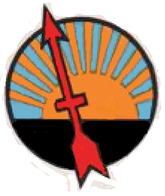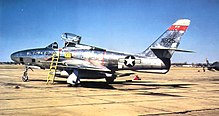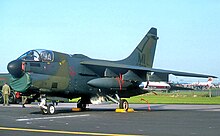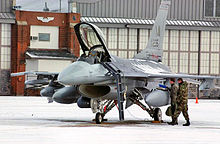107th Fighter Squadron
42°37′36.5″N 82°50′41.6″W / 42.626806°N 82.844889°W
| 107th Fighter Squadron | |
|---|---|
 An A-10 Thunderbolt II, flown by the 107th Fighter Squadron, 127th Wing, returns to Selfridge Air National Guard Base, Michigan, after a local training mission on December 28, 2022. | |
| Active | 1917–1919; 1926–1945; 1946–1952; 1952–present |
| Country | United States |
| Allegiance | |
| Branch | |
| Type | Squadron |
| Role | Close Air Support |
| Part of | Michigan Air National Guard |
| Garrison/HQ | Selfridge Air National Guard Base, Michigan |
| Nickname(s) | The Red Devils[1] |
| Motto(s) | Videre Est Scire Latin To See is to Know (1954),[2] Mors Hostibus (Latin) Death to the Enemy |
| Engagements | World War II Korean War Operation Desert Storm Operation Northern Watch Operation Southern Watch Operation Iraqi Freedom |
| Decorations | Distinguished Unit Citation Air Force Outstanding Unit Award |
| Commanders | |
| Current commander | Brig. Gen. Matthew G. Brancato |
| Deputy Commander | Col. David J. Spehar |
| Wing Commander Chief | Chief Master Sgt. Richard D. Gordon |
| Insignia | |
| 107th Fighter Squadron emblem (approved 16 September 1954)[2] |  |
| 107th Observation Squadron emblem[3] |  |
| Tail code | MI Selfridge in black letters |
The 107th Fighter Squadron is a unit of the Michigan Air National Guard 127th Wing. It is assigned to Selfridge Air National Guard Base, Michigan and is equipped with the Fairchild Republic A-10 Thunderbolt II aircraft.
The squadron is a descendant organization of the World War I 107th Aero Squadron, established on 27 August 1917. It was reformed on 7 May 1926, as the 107th Observation Squadron, and is one of the 29 original National Guard Observation Squadrons of the United States Army National Guard formed before World War II.
History
[edit]World War I
[edit]The 107th Fighter Squadron traces its origins to 26 August 1917 with the organization of the 107th Aero Squadron. Forty recruits arrived at Kelly Field, San Antonio, Texas from Vancouver Barracks, Washington. An additional 341 recruits arrived from Fort Thomas, Kentucky, and 110 men and along with the 40 from Vancouver were formed as the 107th. The squadron was initially indoctrinated into military service, performing drill, fatigue duties and also construction work at the field. Once basic indoctrination training was completed, the 107th was ordered for overseas duty, being ordered to report to the Aviation Concentration Center, Garden City, Long Island on 26 October. It was there that final arrangements were made for the trip overseas, complete equipment was drawn and a final few transfers were made.[4]
On 7 December, the 107th was ordered to proceed by train to St. John's, Newfoundland. On 10 December it boarded the SS Tuscania (1914) for the cross-Atlantic voyage, arriving on Christmas morning at Liverpool, England. After a brief rest, the squadron arrived at Southampton, England on the 29th, and crossed the English Channel to Le Havre, France. There, it then traveled by train to the Replacement Concentration Center, American Expeditionary Forces, St. Maixent Replacement Barracks, France, arriving on 2 January 1918. At St. Maixent the squadron was redesignated as the 801st Aero Squadron, and placed on camp duty for nearly two months. Finally, it was ordered to proceed to the Third Aviation Instruction Center at Issoudun Aerodrome, in central France, arriving on 21 February. Initially the squadron was assigned to the main airfield, working in the aircraft assembly and test departments. On 7 June, help was needed at Field No. 2, and the 801st was ordered to send 100 men to help put the field in better shape. Cooperating with another squadron, Field No. 2 was placed on an efficient basis as any field in the AEF.[4]
The squadron remained at Issoudun until after the Armistice with Germany in November 1918, then returned to the United States in March 1919. Arrived at Mitchel Field where the squadron members were demobilized and returned to civilian life.[4][note 1]
Intra-war period
[edit]After the war the squadron was reorganized in 1925 as the Michigan National Guard's first flying unit, the squadron consisted of 20 officers and 90 enlisted men meeting weekly in a Detroit garage. It received Federal recognition in May 1926 as the air section of the Michigan National Guard's 32d Division. Its primary mission was artillery spotting and observation of troop movements.[5]
In March 1938, elements of the 107th Observation Squadron performed gunnery training at Eglin Field, Florida, for 15 days, deploying from Wayne County Airport at Detroit, Michigan. 23 officers and 111 men arrived on 1 March. One detachment flew in eight aircraft while the rest arrived by rail over the Louisville and Nashville Railroad at Crestview, Florida.[6]
World War II
[edit]Called to active duty with Douglas O-38 and North American O-47 observation planes on 15 October 1940, the 107th was sent to DeRidder Army Air Base, Louisiana for unit training on 28 October 1940. For many years this airfield was simply called the Artillery Range Airport Camp.
On 11 April 1941, Lieutenant Wilmer Esler was killed in the crash of his O-47 when it experienced an engine failure on takeoff.[7] The War Department announced on 19 June 1941 that the Air Corps field at Camp Beauregard would be named Esler Field in honor of his sacrifice.[8]
In 1941, the 107th was joined by two other National Guard observation units to form the 67th Observation Group. The 67th Group did anti-submarine patrolling off the East Coast of the US from mid-December 1941 to March 1942, when it returned to Louisiana for training in fighter aircraft.
The 67th Group was sent to RAF Membury, England, in August 1942 and flew Supermarine Spitfire Mk. Vs and De Havilland Tiger Moths for a year until equipped with North American F-6 Mustangs. Pre-invasion missions began in December 1943. For successful photo missions of the French invasion coastline without loss of a single aircraft, the 107th was awarded the Presidential Unit Citation on 7 April 1945. The 67th Group advance detachments landed in Normandy 13 days after D-Day. The Belgian Fourragere was awarded for conspicuous action during the Battle of the Bulge.
In June 2018, A-10s from the 107th flew over Normandy Beach as part of anniversary observances of D-Day. It was the first official mission for the 107th over Normandy since the end of World War II.
Michigan Air National Guard
[edit]


The wartime 107th Tactical Reconnaissance Squadron was redesignated as the 107th Bombardment Squadron (Light), and was allotted to the National Guard on 24 May 1946. It was organized at Wayne County Airport, Michigan on 9 June 1946 and was extended federal recognition in September. It was assigned to the newly organized Michigan National Guard's 127th Fighter Group. The squadron was equipped with F-51H Mustang.
In 1950, the unit was converted to Republic F-84B Thunderjet jets and on 1 February 1951, the unit was activated as part of the 127th Pilot Training Group and moved to Luke Air Force Base, Arizona. The 107th was inactivated and returned to Michigan in November 1952.
F-16s from the 107th Fighter Squadron deployed to Kirkuk Air Base in February 2004 to replace the 354th Fighter Squadron. The 107th became the first General Dynamics F-16 Fighting Falcon unit to be based in Iraq. The unit returned home in early June 2004.
As a result of the 2005 Base Realignment and Closure decision, the 107th converted from the F-16 to the Fairchild Republic A-10 Thunderbolt II.[9] The 107th flew its last sortie with F-16s on 16 December 2008. The three remaining F-16s on the base were scheduled to be transferred to Fort Wayne Air National Guard Station, Indiana, and twenty-four A-10s are scheduled to arrive at Selfridge in May 2009.[10]
Lineage
[edit]- 107th Aero Squadron
- Organized as the 107th Aero Squadron on 27 August 1917[note 4]
- Redesignated: 801st Aero Squadron on 1 February 1918
- Redesignated: 801st Aero Squadron (Repair) on 21 February 1918
- Demobilized on 18 March 1919
- Reconstituted and consolidated with the 107th Observation Squadron as the 107th Observation Squadron on 20 October 1936[11][12]
- 107th Fighter Squadron
- Constituted as the 107th Squadron (Observation) and allotted to the Michigan National Guard in 1921[12]
- Redesignated 107th Observation Squadron on 25 January 1923[12]
- Organized and federally recognized on 7 May 1926
- Consolidated with the 801st Aero Squadron on 20 October 1936[12]
- Ordered to active service on 15 October 1940
- Redesignated 107th Observation Squadron (Light) on 13 January 1942
- Redesignated 107th Observation Squadron on 4 July 1942
- Redesignated 107th Reconnaissance Squadron (Fighter) on 31 May 1943
- Redesignated 107th Tactical Reconnaissance Squadron on 13 November 1943
- Inactivated on 9 November 1945
- Redesignated 107th Bombardment Squadron (Light) and allotted to the National Guard on 24 May 1946[11]
- Activated on 9 July 1946
- Federally recognized 26 September 1946[5]
- Redesignated 107th Fighter Squadron, Jet on 1 July 1950[5]
- Ordered into active service on 1 February 1951
- Redesignated 107th Pilot Training Squadron on 1 February 1951
- Inactivated, relieved from active duty and returned to the National Guard on 1 November 1952
- Redesignated 107th Fighter-Bomber Squadron and activated in the Michigan Air National Guard on 1 November 1952[5]
- Redesignated 107th Fighter-Interceptor Squadron on 1 July 1955[5]
- Redesignated 107th Tactical Reconnaissance Squadron, Photo-Jet on 12 April 1958[5]
- Redesignated 107th Tactical Fighter Squadron on 30 June 1972
- Redesignated 107th Fighter Squadron on 31 March 1992
Assignments
[edit]- Post Headquarters, Kelly Field, 27 August 1917
- Aviation Concentration Center, 31 October – 7 December 1917
- Replacement Concentration Center, American Expeditionary Forces, 2 January 1918
- Third Aviation Instruction Center, 21 February 1918
- Services of Supply, American Expeditionary Forces, 4 January–8 March 1919
- Eastern Department, 8–18 Mar 1919
- 32d Division Air Service (later Divisional Aviation, 32d Division), 7 May 1926[13]
- Attached to 32d Division, 15 February 1929[12]
- 46th Observation Group, 1 October 1933[12]
- Fourth Corps Area 15 October 1940
- V Army Corps, c. December 1940
- 67th Observation Group (later 67th Reconnaissance Group, 67th Tactical Reconnaissance Group), 1 September 1941 – 9 November 1945[11]
- 127th Fighter Group, 29 September 1946
- 66th Fighter Wing, 26 November 1946
- 126th Bombardment Group, February 1947
- 127th Fighter Group (later 127th Pilot Training Group), c. 1 July 1950 – 1 November 1952
- 127th Fighter-Bomber Group (later 127th Fighter-Interceptor Group, 127th Fighter Group, 127th Tactical Reconnaissance Group, 127th Tactical Fighter Group), 1 November 1952
- 127th Tactical Fighter Wing (later 127th Fighter Wing), 9 December 1974
- 127th Operations Group, c. 1 January 1993 – present
Stations
[edit]
|
|
Aircraft
[edit]
|
|
See also
[edit]- List of American aero squadrons
- List of observation squadrons of the United States Army National Guard
References
[edit]- Notes
- ^ Maurer and Clay both say Gardem City was the demobilization location. Maurer, Combat Squadrons, p. 336, Clay, p. 1446. There were several installations there, including Fort Mills, Kindley Field and Hazelhurst Field in addition to Mitchel.
- ^ Aircraft is RF-84F Thunderstreak serial 51-1925, about 1960
- ^ Aircraft is General Dynamics F-16C Block 30 serial 86–235 at Selfridge ANGB with the pilot and crew chief right going over the forms during preparations to deploy on 24 February 2004.
- ^ This unit is not related to another 107th Aero Squadron that was activated in March 1918 at Rich Field, Waco, Texas, moved the same month to Carlstrom Field, Florida, redesignated Squadron A, Carlstrom Field in July 1918 and demobilized in November 1918, with its personnel and equipment being transferred to the Flying School Detachment, Carlstrom Field.
- Citations
- ^ "Fact Sheet 107th Fighter Squadron" (PDF). 127wg.ang.af.mil.
- ^ a b Maurer, Combat Squadrons, pp. 336–337
- ^ Hubbard, p. 719
- ^ a b c Gorrell, [page needed]
- ^ a b c d e f g h i j Jongerman, Fritz (January 2004). "Order of Battle: 107th FS". Aviamagazine.com. Retrieved 19 August 2017.
- ^ Crestview, Florida, "Aerial Squadron Flies Eight Planes To Val-P For Gunnery Practice", Okaloosa News-Journal, Crestview, Florida, Friday 4 March 1938, Volume 24, Number 10, page 6.
- ^ "April 1941 USAAF Accident Reports". Aviation Archaeological Investigation and Research. Retrieved 9 January 2007.
- ^ "Louisiana Maneuver Camps and Bases". Louisiana: World Renown Involvement in World War II. Louisiana Department of Culture, Recreation and Tourism. Archived from the original on 7 December 2008. Retrieved 9 January 2007.
- ^ "Red Devils Return to Michigan." Press Release. Michigan.gov. Retrieved 4 November 2007. New Page 2
- ^ "F-16s fly away from Selfridge" Chad Selweski, Macomb Daily. Retrieved 19 December 20087. F-16s fly away from Selfridge – macombdaily.com Archived 18 February 2012 at the Wayback Machine
- ^ a b c Lineage, including assignments, through May 1946 in Maurer, Combat Squadrons, pp. 336–337, except as noted.
- ^ a b c d e f Clay, p. 1443
- ^ Clay, p. 1275
- ^ a b c d e Station number in Anderson.
- ^ a b c d e f g h Station number in Johnson.
- ^ Stations through 1945 in Maurer, Combat Squadrons, pp. 336–337, except as noted.
- ^ William J Brenell (Spring 2004). "The Known North American O-47 Assigned to Pre-World War II Air National Guard Squadrons". AAHS Journal.
Bibliography
[edit]![]() This article incorporates public domain material from the Air Force Historical Research Agency
This article incorporates public domain material from the Air Force Historical Research Agency
- Anderson, Capt. Barry (1985). Army Air Forces Stations: A Guide to the Stations Where U.S. Army Air Forces Personnel Served in the United Kingdom During World War II (PDF). Maxwell AFB, AL yes: Research Division, USAF Historical Research Center. Archived from the original (PDF) on 23 January 2016. Retrieved 28 June 2017.
- Clay, Steven E. (2011). US Army Order of Battle 1919–1941 (PDF). Vol. 3 The Services: Air Service, Engineers, and Special Troops 1919–1941. Fort Leavenworth, KS: Combat Studies Institute Press. ISBN 978-0-98419-014-0. LCCN 2010022326. OCLC 637712205. Archived from the original (PDF) on 27 September 2013. Retrieved 16 October 2012.
- Gorrell, Col. Edgar S. (1974). History of the American Expeditionary Forces Air Service, 1917–1919. Series E. Vol. 25 History of the 800th–1111th Aero Squadrons. Washington, DC: National Archives and Records Service, General Services Administration. OCLC 215070705.
- Hubbard, Gerard (June 1943). "Aircraft Insignia, Spirit of Youth". Vol. LXXXIII (No. 6) National Geographic, pp. 710–722
- Johnson, 1st Lt. David C. (1988). U.S. Army Air Forces Continental Airfields (ETO) D-Day to V-E Day (PDF). Maxwell AFB, AL: Research Division, USAF Historical Research Center. Archived from the original (PDF) on 29 September 2015. Retrieved 26 June 2017.
{{cite book}}: CS1 maint: numeric names: authors list (link) - Maurer, Maurer, ed. (1983) [1961]. Air Force Combat Units of World War II (PDF) (reprint ed.). Washington, DC: Office of Air Force History. ISBN 0-912799-02-1. LCCN 61060979. Retrieved 17 December 2016.
- Maurer, Maurer, ed. (1982) [1969]. Combat Squadrons of the Air Force, World War II (PDF) (reprint ed.). Washington, DC: Office of Air Force History. ISBN 0-405-12194-6. LCCN 70605402. OCLC 72556. Retrieved 17 December 2016.

